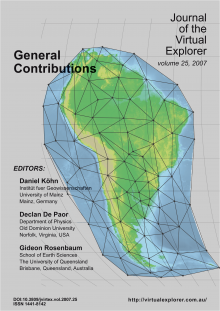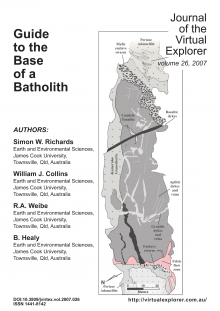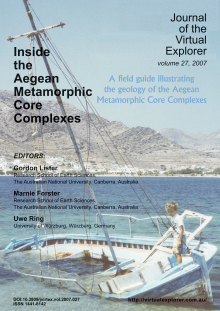- Home
- Journal
- 2017 -- 50, 51
- 2016 -- 49, 50
- 2015 -- 48
- 2014 -- 46, 47
- 2013 -- 44, 45
- 2012 -- 40, 41, 42, 43
- 2011 -- 37, 38, 39
- 2010 -- 35, 36
- 2009 -- 31, 32, 33, 34
- 2008 -- 28, 29, 30
- 2007 -- 25, 26, 27
- 2006 -- 21, 22, 23, 24
- 2005 -- 18, 19, 20
- 2004 -- 14, 15, 16, 17
- 2003 -- 10, 11, 12, 13
- 2002 -- 6, 7, 8, 9
- 2001 -- 3, 4, 5
- 2000 -- 1, 2
- Editorial Board
- Policies
2007 Issues
Edited by:
A software package (Pplates) has been developed which enables tectonic reconstructions to be done with allowances for deformation within and between plates. To do this, the software moves and deforms representations of earth topology by moving and deforming meshes (irregularly tessellated polyhedrons) consisting of planar triangular mesh faces. Each mesh corresponds to a surface represented in three dimensions and placed to conform to the surface of the earth. A general coordinate transformation matrix relating the initial to the final positions of the three vertices of each mesh face is calculated and used analogously to a deformation gradient tensor. When incorporating increasingly detailed intra-plate deformation in a reconstruction, moving objects via a deformable mesh becomes more attractive than creating ever-smaller sub-plates. This paper reviews several tectonic reconstructions of the break up of South America and Africa and demonstrates how they can be enhanced through the use of the reconstruction software.
Edited by:
This volume is a field guide to the base of the Bega Batholith. The field guide describes a trip to examine granite plutons, layered mafic complexes and related country rocks. These rocks are slightly younger (~422 Ma) than those at Cooma (~435 Ma), ~70 km to west. At Cooma we can view some classic metamorphic rocks with well-developed structures and obvious migmatitic leucosomes. In contrast, the structures and rocktypes observed on this trip are unusual. The granite is a classic granodiorite but the migmatites are schlieren migmatites and are quite distinct from the classic layered migmatites (metatexites) which are common in high-temperature metamorphic complexes around the world.
Many of the magmatic structures and features observed over the two days are comparable to sedimentary structures so much of the trip will be focused on identification and interpretation of these structures and how the recognition of these features influences our view of mechanisms of pluton construction. In turn, we can discuss the role that plutons can play as a significant tectonic indicator, just like classic structures such as folds and faults
Edited by: Gordon S. Lister
The Aegean metamorphic core complexes were discovered as the result of a thesis study conducted by Greetje Banga (1983), when she was at the Institute of Earth Sciences at the University of Utrecht. She conducted one of the first studies of the fabrics and microstructures of the Cycladic islands. Her work lead to the recognition of the major ductile shear zone that forms the mylonitic carapace of the Ios dome). Banga’s thesis provided the basic data that led to the hypothesis that ductile stretching of the Aegean continental crust had taken place during Oligo-Miocene extensional tectonism.
Core complexes in the Cyclades can be compared to the core complexes of the Colorado River extensional corridor in the U.S. Cordillera. The first edition of this field guide was for a Penrose Conference in Crete in 1996. The second edition contains some minor modifications, and corrections. Download second edition of "Inside the Aegean Metamorphic Core Complexes" from URL http://virtualexplorer.com.au/article/2007/167/inside-the-aegean-metamor...


